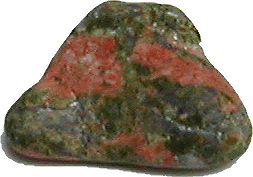
 |
In focus: Unakite |
| Chemical Composition: Granite composted of feldspar, epidote and quartz | |
| Group: Epidote Group | |
| Colour: Mixture of green, yellow-green and pink | |
| Streak: | |
| Hardness: 6-7 | |
| Density: 2.55 - 2.85 | |
| Luster: Pearly | |
| Cleavage: Irregular |
|
Unakite is a type of granite. It is composed of salmon-pink feldspar (feldspars are an important group of rock-forming minerals which make up perhaps as much as 60% of the Earth's crust), green epidote, and quartz. Unakite is named after the Unaka range of the Great Smoky mountain range of eastern Tennessee and western North Carolina where it was originally docoverd by a Mr Bradley in 1874. Unakite is also sometimes called epidotized granite. |
In nature, Unakite typically occurs in granitic masses, especially in dikes (ridges of harder rock) and lenses (flat, thin plates of rock). It is widely distributed in the United States. It is found particularly in the Blue Ridge mountains, but also in the beach rock on the shores of Lake Superior, and as river pebbles. Unakite is the state stone of Virginia. Outside the United states, Unakite is mined in South Africa, Brazil, and China. Unakite from different regions varies in the amount of quartz it contains and some minerologists argue that rocks containing a very small amount of quartz should be reffered to as unakite-like rather than the real McCoy.
A good specimen of Unakite, containing a high percentage of quartz, is considered as a semi-precious stone. It is easy to polish and makes an interesting choice of jewellery; predominently as tumbled chips, cabochons, faceted and freeform. On occasions Unakite has been used for making tiles, a particularly notable example being the floor tiles of the main terrace of the National Museum of Natural History (Smithsonian Institution) in Washington, D.C.
| _______________________________ | ||||
| Home | | | Shopping | | | Database |
© Biscuit Software 2004-2015
All rights reserved